Comparison of the Cone Penetration Resistance Obtained in Static CPTu, and Dynamic DPL and PANDA In Situ Tests
Abstract
1. Introduction
2. Penetrometer PANDA
- qd—dynamic cone resistance [MPa], E—drive energy [J], A—cone section [m2], e′—penetration [m], M—hammer mass [kg], P—total driven mass (extension rods, anvil) [kg].
3. Research Methodology
3.1. Test Site
3.2. Field Tests
4. Statistical Analysis of Research Results
5. Conclusions
Author Contributions
Funding
Data Availability Statement
Conflicts of Interest
Correction Statement
References
- PN-EN 1997-2:2007; Eurocode 7. Geotechnical Design—Part 2: Ground Investigation and Testing. European Committee for Standardization: Brussels, Belgium, 2007.
- Godlewski, T. Interpretacja badań polowych a Eurokod 7. Acta Sci. Polonorum. Archit. 2013, 12, 61–72. [Google Scholar]
- Czado, B.; Pietras, J. Comparison of the cone penetration resistance obtained in static and dynamic field tests. AGH J. Min. Geoengin. 2012, 36, 97–105. [Google Scholar] [CrossRef]
- Benz-Navarrete, M.A.; Breul, P.; Bacconet, C.; Moustan, P. The PANDA®, Variable Energy Lightweight Dynamic Cone Penetrometer: A Quick State of Art. Available online: https://insitutek.com/wp-content/uploads/2022/06/The-PANDA-Variable-Energy-Lightweight-Dynamic-Cone-Penetrometer-A-quick-state-of-art-Benz-Navarrete-Breul-Bacconet-and-Moustan-2019.pdf (accessed on 6 May 2025).
- Langton, D. The Panda lightweight penetrometer for soil investigation and monitoring material compaction. Ground Eng. 1999, 32, 33–37. [Google Scholar]
- Maślakowski, M.; Brzeziński, K.; Zbiciak, A.; Józefiak, K. Validation of the cone penetrometer suitability for determining the state of soil. Arch. Civ. Eng. 2018, 64, 265–280. [Google Scholar] [CrossRef]
- Kraszewski, C.; Dreger, M.; Szpikowski, M.; Mitrut, M.; Sobkowicz, P. Assesment of bearing capacity of subgrade and track bed of railways lines with dynamic probe. Inżynieria Morska I Geotech. 2019, 4, 182–187. [Google Scholar]
- Gourves, R.; Barjot, R. The panda ultralight dynamic penetrometer. In Proceedings of the 11th European Conference on Soil Mechanics and Foundation Engineering, Copenhagen, Denmark, 28 May—1 June 1995; Volume 10, pp. 83–88. [Google Scholar]
- XP P94 105; French Std for Compaction Quality—Insitu Test. Méthode au Pénétromètre Dynamique à Énergie Variable—Principe et Méthode D’étalonnage du Pénétromètre—Exploitation des Résultats—Interprétation. AFNOR: Paris, France, 2012.
- Benz-Navarrete, M.A.; Breul, P.; Arancibia, G.V.; Moustan, M. Correlation Between Static (CPT) and Dynamic Variable Energy (P.A.N.D.A.) Cone Penetration Tests. Available online: http://isc6.org/images/Cikkek/Sessions/ISC2020-421.pdf (accessed on 26 April 2025).
- Tsuchida, T.; Athapaththu, A.M.R.G.; Kano, S.; Suca, K. Estimation of In-Situ Shear Strength Parameters of Weathered Granitic (MASADO) Slopes Using Lightweight Dynamic Cone Penetrometer. Soils Found. 2011, 51, 497–512. [Google Scholar] [CrossRef]
- Latvala, J.; Luomala, H.; Kolisoja, P. Determining Soil Moisture Content and Material Properties with Dynamic Cone Penetrometer. Balt. J. Road Bridge Eng. 2010, 15, 136–159. [Google Scholar] [CrossRef]
- Khodaparast, M.; Rajabi, A.M.; Mohammadi, M. The new empirical formula based on dynamic probing test results in fine cohesive soils. Int. J. Civ. Eng. 2015, 13, 105–113. [Google Scholar]
- Benz-Navarrete, M.A.; Breul, P.; Gourvès, R. Application of wave equation theory to improve dynamic cone penetration test for shallow soil characterization. J. Rock Mech. Geotech. Eng. 2022, 14, 289–302. [Google Scholar] [CrossRef]
- EN ISO 22476-2:2005; Geotechnical Investigation and Testing—Field Testing—Part 2: Dynamic Probing. European Committee for Standardization (CEN): Brussels, Belgium, 2005.
- EN ISO 22476-1:2022; Geotechnical Investigation and Testing—Field Testing—Part 1: Electrical Cone and Piezocone Penetration Tests. European Committee for Standardization (CEN): Brussels, Belgium, 2022.
- EN ISO 14688-1:2018; Geotechnical Investigation and Testing—Identification and Classification of Soil—Part 1: Identification and Description. European Committee for Standardization (CEN): Brussels, Belgium, 2018.
- ISO 17892-4:2016; Geotechnical Investigation and Testing—Laboratory Testing of Soil. Part 4: Determination of Particle Size Distribution. International Organization for Standardization (ISO): Geneva, Switzerland, 2016.
- Stanisz, A. An Accessible Course of Study in Statistics Using STATISTICA PL, Based on Medical Example. Vol. 2. Linear and Nonlinear Models; StatSoft: Cracow, Poland, 2007; ISBN 9788388724305. [Google Scholar]
- Waschkowski, E. Essais de pénétration—Le pénétromètre dynamique. Bull. Liaison Lab. Ponts Chaussées 1983, 125, 95–103. [Google Scholar]


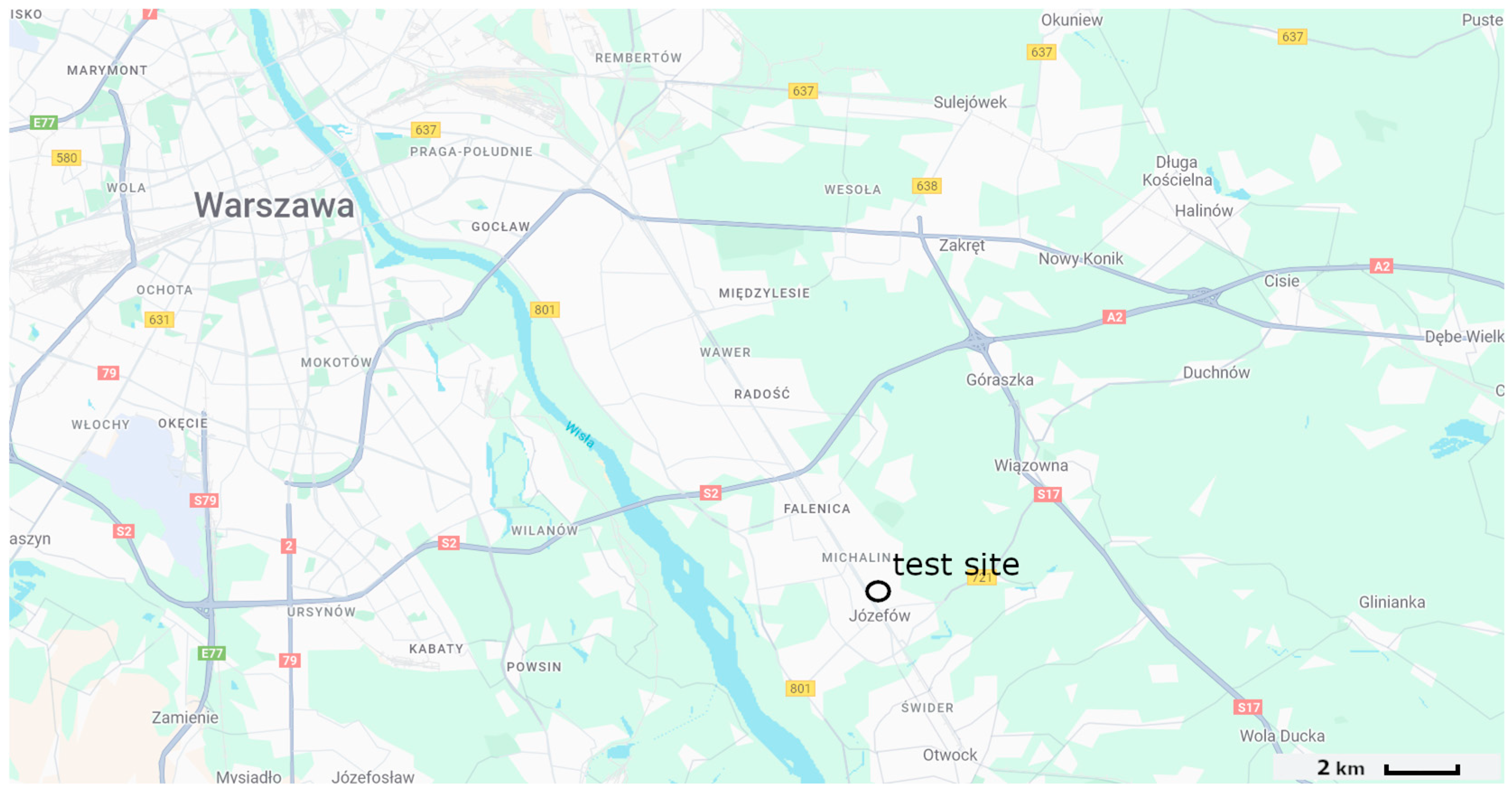
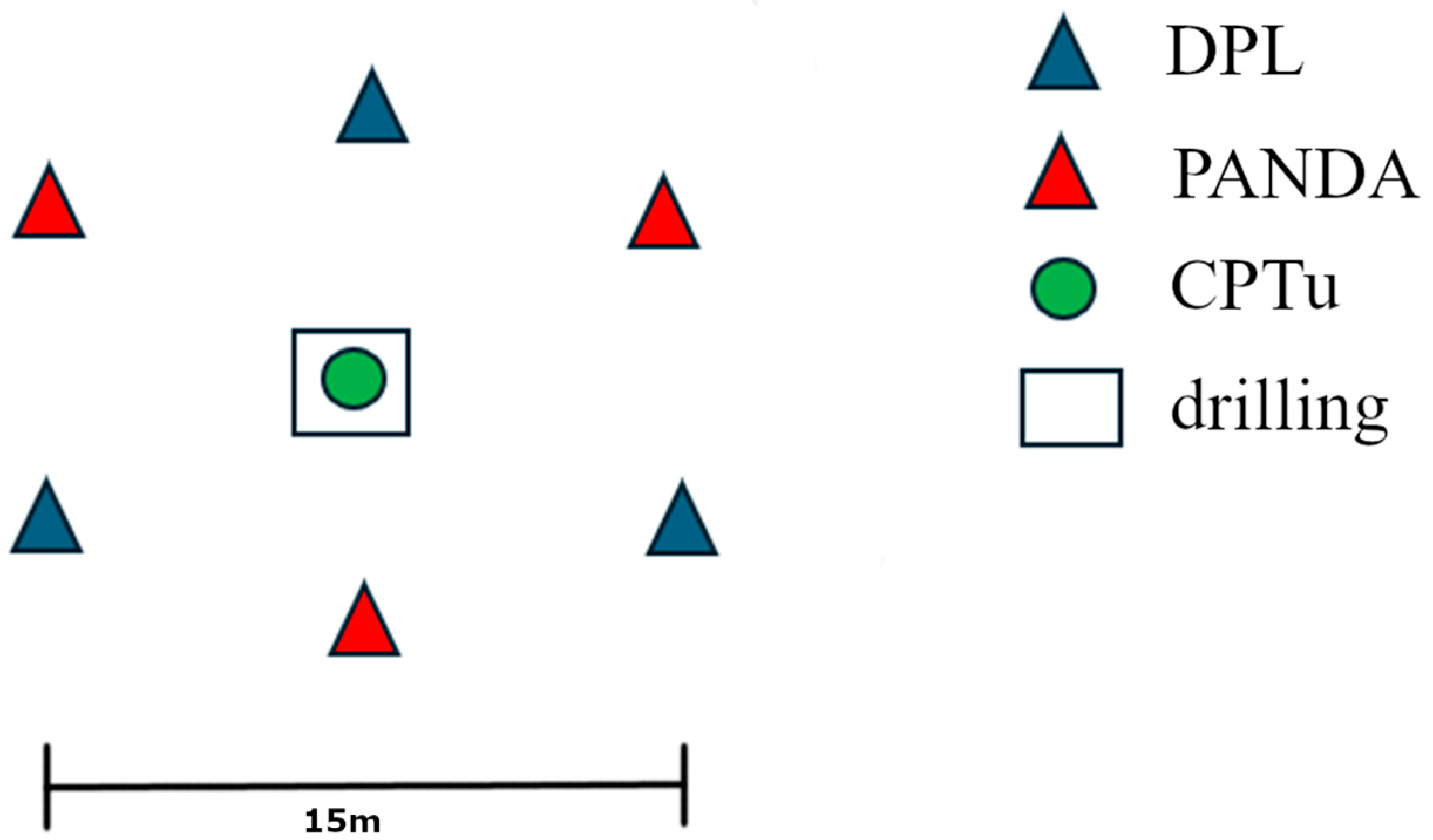
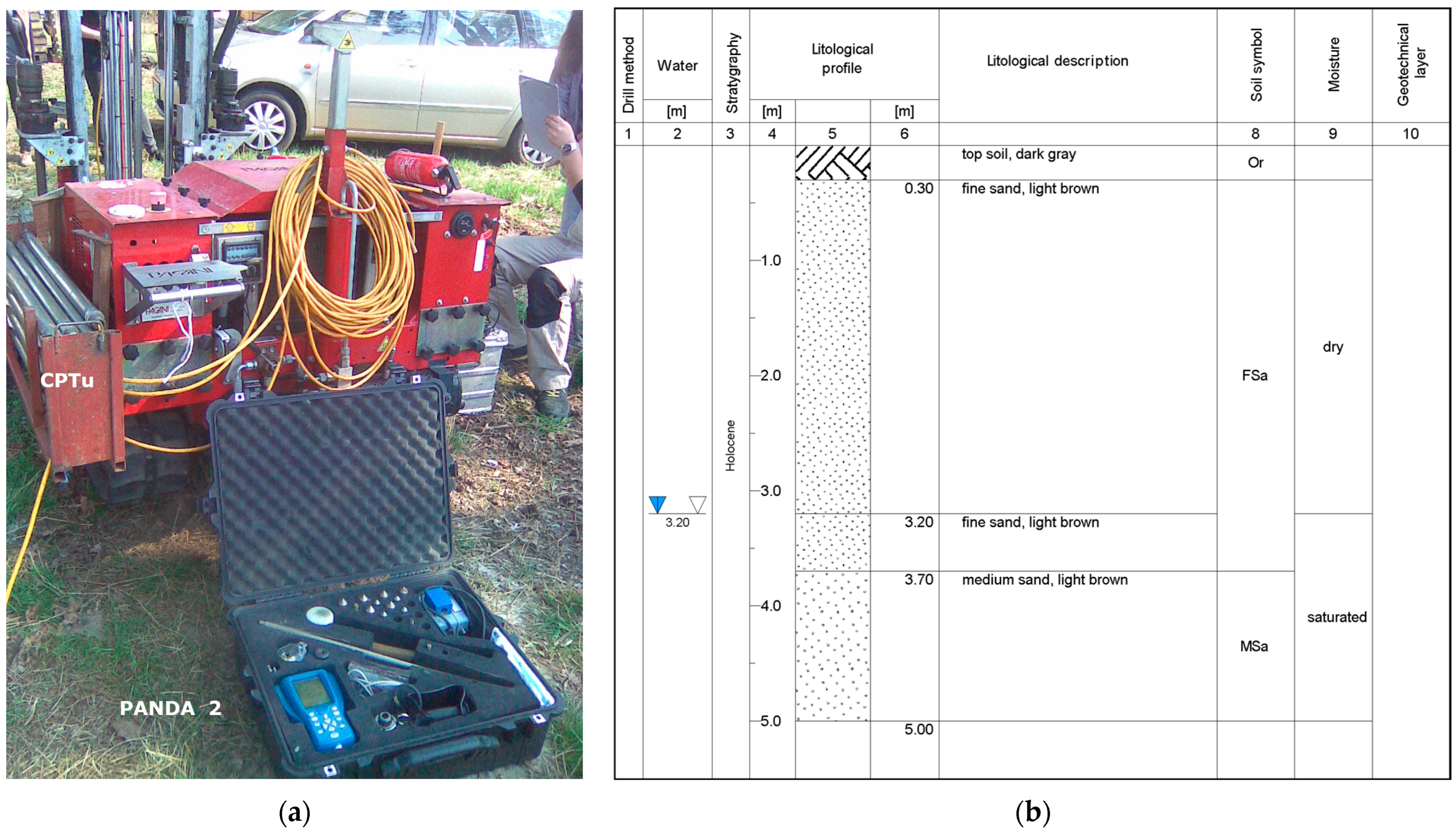
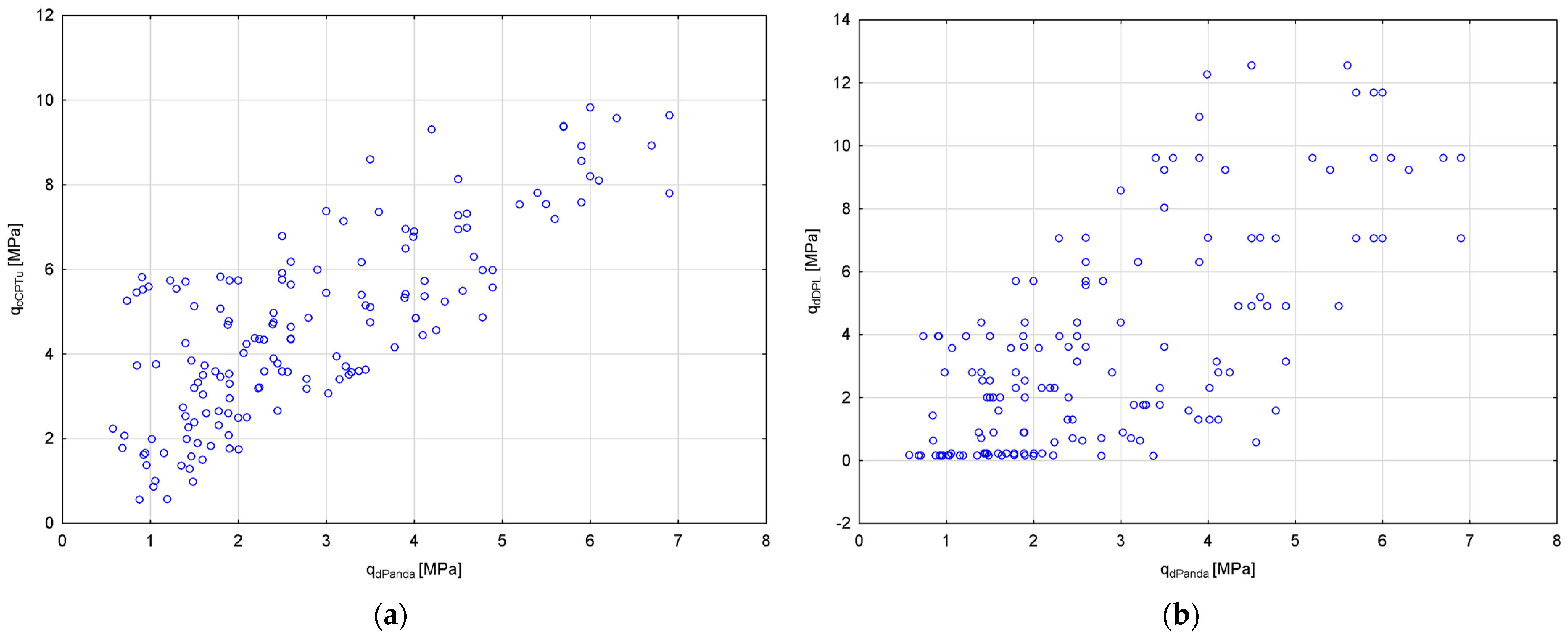

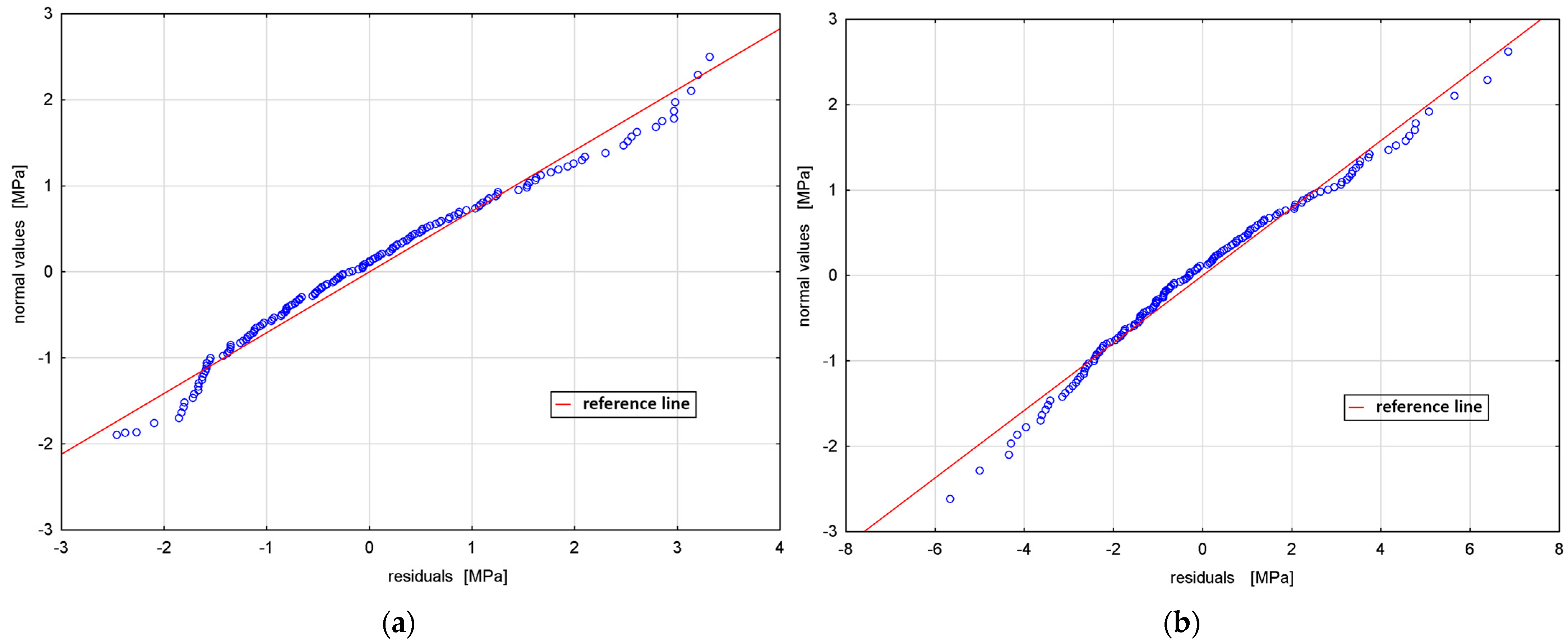
| Hammer | Mass [kg] | 2.0 | ||
| Standard drop | Variable (measured) | |||
| Anvil | Mass [kg] | 2.16 | ||
| Cone | Area [cm2] | 2.0 | 4.0 | 10.0 |
| Angle [°] | 90.0 | 90.0 | 90.0 | |
| Diameter [mm] | 16.0 | 22.5 | 35.7 | |
| Tip length [cm] | 1.1 | 1.6 | 2.5 | |
| Extension rods | Mass [kg] | 0.586 | ||
| Tip length [cm] | 0.5 | |||
| Diameter [cm] | 1.4 | |||
| Soil | Particle Size Ratio | Fraction Content [%] | |||||
|---|---|---|---|---|---|---|---|
| ≤0.063 | 0.063 < d ≤ 0.20 | 0.20 < d ≤ 0.63 | 0.63 < d ≤ 2.0 | >2.0 | |||
| FSa | 0.94 | 1.80 | 6.0 | 53.0 | 30.0 | 10.0 | 1.0 |
| MSa | 1.13 | 2.67 | 1.0 | 17.0 | 69.0 | 12.0 | 1.0 |
| Number of Measurements n [-] | Mean Value [MPa] | Minimum Value [MPa] | Maximum Value [MPa] | Standard Deviation [MPa] | Coefficient of Variation [%] | |
|---|---|---|---|---|---|---|
| qdDPL | 150 | 3.68 | 0.14 | 12.55 | 3.40 | 92.39 |
| qdPanda | 150 | 2.83 | 0.58 | 6.90 | 1.56 | 55.12 |
| qcCPTu | 150 | 4.66 | 0.56 | 9.82 | 2.20 | 47.21 |
Disclaimer/Publisher’s Note: The statements, opinions and data contained in all publications are solely those of the individual author(s) and contributor(s) and not of MDPI and/or the editor(s). MDPI and/or the editor(s) disclaim responsibility for any injury to people or property resulting from any ideas, methods, instructions or products referred to in the content. |
© 2025 by the authors. Licensee MDPI, Basel, Switzerland. This article is an open access article distributed under the terms and conditions of the Creative Commons Attribution (CC BY) license (https://creativecommons.org/licenses/by/4.0/).
Share and Cite
Bartnik, G.; Maślakowski, M.; Godlewski, T.; Nasiłowski, K. Comparison of the Cone Penetration Resistance Obtained in Static CPTu, and Dynamic DPL and PANDA In Situ Tests. Appl. Sci. 2025, 15, 10050. https://doi.org/10.3390/app151810050
Bartnik G, Maślakowski M, Godlewski T, Nasiłowski K. Comparison of the Cone Penetration Resistance Obtained in Static CPTu, and Dynamic DPL and PANDA In Situ Tests. Applied Sciences. 2025; 15(18):10050. https://doi.org/10.3390/app151810050
Chicago/Turabian StyleBartnik, Grzegorz, Maciej Maślakowski, Tomasz Godlewski, and Kamil Nasiłowski. 2025. "Comparison of the Cone Penetration Resistance Obtained in Static CPTu, and Dynamic DPL and PANDA In Situ Tests" Applied Sciences 15, no. 18: 10050. https://doi.org/10.3390/app151810050
APA StyleBartnik, G., Maślakowski, M., Godlewski, T., & Nasiłowski, K. (2025). Comparison of the Cone Penetration Resistance Obtained in Static CPTu, and Dynamic DPL and PANDA In Situ Tests. Applied Sciences, 15(18), 10050. https://doi.org/10.3390/app151810050






